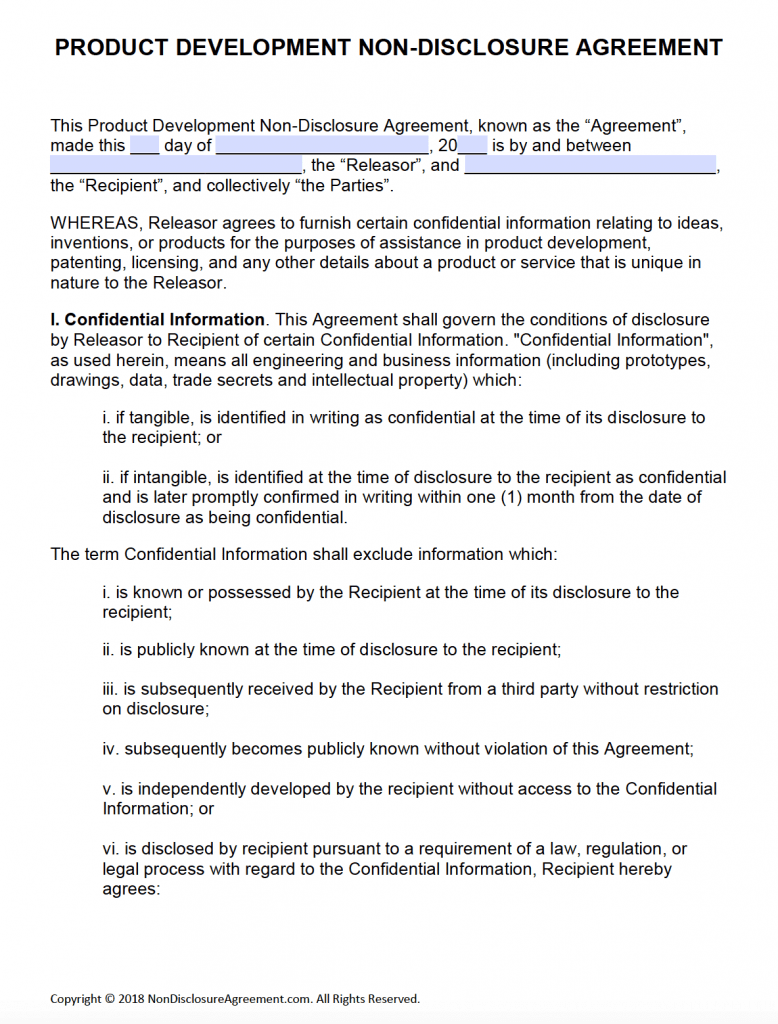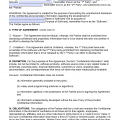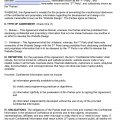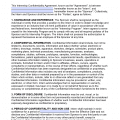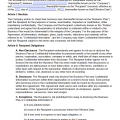Product Development Non-Disclosure Agreement (NDA) – PDF – Word

The product development non-disclosure agreement is for use when an innovator is developing a new product or service (the “Innovation”) and needs to disclose secret information regarding the innovation. New Product Development (NPD) can be a lengthy process and may continue even after the product is commercially available. Typically, it involves several steps, all of which may require an assurance of confidentiality. These NPD steps include idea generation, concept testing, screening, and marketability and metric monitoring, commercialization, and post-commercialization review. Therefore, confidential information is not simply about the product being developed. It may include marketing studies, competitor evaluations, cost analysis, and testing results.
Patent (Invention) NDA – For use after the product is complete and is considered an invention or awaiting patent.
Sample
Product Development Non-Disclosure Agreement
This Product Development Non-Disclosure Agreement (the “Agreement”) is entered into by and between _______________ (“Product Developer”) and __________________ (“Receiving Party”) and is effective _________________. The parties agree to enter into a confidential relationship with respect to preventing the unauthorized disclosure of certain proprietary and confidential information (the “Confidential Information”), as defined below.
1. Product Development
Product Developer is in the business of developing goods and services for commercialization (collectively referred to as the “Product”). Receiving Party wishes to contract with Product Developer – for example, by contributing to the product’s creation, evaluation, testing, marketing, manufacture or sales. In order for the parties to work together, the disclosure of Confidential Information (as defined below) may be necessary.
2. Definition of Confidential Information
For purposes of this Agreement, “Confidential Information” shall include all information or material related to the Product that has or could have commercial value or other utility in the business which Product Developer is engaged and which is not known by competitors. This includes but is not limited to information or data relating to all innovations developed or owned by Product Developer, as well as information in a pending patent, trademark or copyright application, confidential know-how connected with a patent or application, or innovations or strategies that may became the basis of a patent, trademark of copyright application. In the event that Confidential Information is in written form, the Product Developer shall label or stamp the materials with the word “Confidential” or some similar warning.
3. Obligations of Receiving Party
The Receiving Party shall hold and maintain the Confidential Information of the other party in strictest confidence for the sole and exclusive benefit of the Product Developer. The Receiving Party shall carefully restrict access to any such Confidential Information to persons bound by this Agreement, only on a need-to-know basis. The Receiving Party shall not, without prior written approval of the Product Developer, use for the Receiving Party’s own benefit, publish, copy, or otherwise disclose to others, or permit the use by others for their benefit or to the detriment of the Product Developer, any of the Confidential Information. The Receiving Party shall return to Product Developer any and all records, notes, and other written, printed, or tangible materials in its possession pertaining to the Confidential Information immediately on the written request of Product Developer.
4. Exclusions From Confidential Information
Receiving Party’s obligations under this Agreement shall not extend to information that is (a) publicly known at the time of disclosure under this Agreement or subsequently becomes publicly known through no fault of the Receiving Party; (b) discovered or created by the Receiving Party prior to the time of disclosure by Product Developer; or (c) otherwise learned by the Receiving Party through legitimate means other than from the Product Developer or anyone connected with the Product Developer.
5. Term
This Agreement and Receiving Party’s duty to hold Confidential Information in confidence shall remain in effect until _________________ or until whichever of the following occurs first: (a) Product Developer sends Receiving Party written notice releasing it from this Agreement, or (b) Confidential Information disclosed under this Agreement ceases to be confidential.
6. No Rights Granted
This Agreement does not constitute a grant or an intention or commitment to grant any right, title or interest in the Product, the Product Developer’s innovations, intellectual property, or the Confidential Information, to Receiving Party.
7. General Provisions
(a) Relationships. Nothing contained in this Agreement shall be deemed to constitute either party a partner, joint venturer or employee of the other party for any purpose.
(b) Severability. If a court finds any provision of this Agreement invalid or unenforceable, the remainder of this Agreement shall be interpreted so as best to effect the intent of the parties.
(c) Integration. This Agreement expresses the complete understanding of the parties with respect to the subject matter and supersedes all prior proposals, agreements, representations and understandings. This Agreement may not be amended except in a writing signed by both parties.
(d) Waiver. The failure to exercise any right provided in this Agreement shall not be a waiver of prior or subsequent rights.
(e) Injunctive Relief. Any misappropriation of Confidential Information in violation of this Agreement may cause Product Developer irreparable harm, the amount of which may be difficult to ascertain, and therefore Receiving Party agrees that Product Developer shall have the right to apply to a court of competent jurisdiction for an order enjoining any such further misappropriation and for such other relief as Product Developer deems appropriate. This right of Product Developer is to be in addition to the remedies otherwise available to Product Developer.
(f) Attorney Fees and Expenses. In a dispute arising out of or related to this Agreement, the prevailing party shall have the right to collect from the other party its reasonable attorney fees and costs and necessary expenditures.
(g) Governing Law. This Agreement shall be governed in accordance with the laws of the State of _________________.
(h) Jurisdiction. The parties consent to the exclusive jurisdiction and venue of the federal and state courts located in _________________ in any action arising out of or relating to this Agreement. The parties waive any other venue to which either party might be entitled by domicile or otherwise.
(i) Successors & Assigns. This Agreement shall bind each party’s heirs, successors and assigns. Receiving Party may not assign or transfer its rights or obligations under this Agreement without the prior written consent of Product Developer. However, no consent is required for an assignment or transfer that occurs: (a) to an entity in which Receiving Party owns more than fifty percent of the assets; or (b) as part of a transfer of all or substantially all of the assets of Receiving Party to any party. Any assignment or transfer in violation of this section shall be void.
Product Developer:
_____________________________________________ (Signature)
_____________________ (Typed or Printed Name)
Title: _____________________
Date: _____________________
Receiving Party:
_____________________________________________ (Signature)
_____________________ (Typed or Printed Name)
Title: _____________________
Date: _____________________
How to Write
EXPLANATION FOR PRODUCT DEVELOPMENT NON-DISCLOSURE AGREEMENT
Below we provide an explanation for each of the provisions in Product Development Non-Disclosure Agreement.
Introductory Paragraph
Fill in the name or company name of the party developing the product or service. Fill in the name of the individual or company evaluating or assisting in the development of the Product (for example, a marketing firm or manufacturer) (the “Receiving Party”). Finally, fill in the date the agreement will take effect. This is often the date that the last party signs the agreement.
1. Product Development
This section provides a summary of the development process and definition of “Product”.
2. Definition of Confidential Information
This section defines what is protected against disclosure. Keep in mind that if you are providing documentation, you should designate that information as confidential. If the information is spoken, you should announce the confidentiality.
3. Obligations of Receiving Party
This clause makes clear that your trade secrets must be kept in confidence by the receiving party and may not be revealed to others without your prior written consent.
The receiving party also promises to return materials that you provided.
4. Exclusions
This provision describes all the types of information that are not covered by the agreement. These exclusions are based on court decisions and state trade secret laws that say these types of information do not qualify for trade secret protection.
5. Term
This clause provides the receiving party with an expiration date for the agreement. The Agreement should last as long as the information is likely to remain a trade secret. Five years is a common period, but it can be much shorter, even as little as six months.
6. No Rights Granted
This clause makes clear that you are not granting any ownership rights in your intellectual property or the confidential information to the receiving party.
7. General Provisions
These miscellaneous provisions (sometimes referred to as “boilerplate”) are usually grouped together at the end of an agreement.
(a) Relationships. Most agreements include a provision like this one, disclaiming any relationship other than that defined in the agreement.
(b) Severability. The severability clause provides that if you wind up in a lawsuit over the agreement and a court rules that one part of the agreement is invalid, that part can be cut out and the rest of the agreement will remain valid.
(c) Integration. The integration provision verifies that the version you are signing is the final version and that neither of you can rely on statements made in the past.
(d) Waiver. This provision states that even if you don’t promptly complain about a violation of the NDA, you still have the right to complain about it later.
(e) Injunctive Relief. An injunction is a court order directing a person to do (or stop doing) something. If someone violated your NDA, you would want a court order directing that person to stop using your secrets.
(f) Attorney Fees and Expenses. If you don’t include an attorney fees clause in your agreement, a judge may (in most states) order the award of attorney fees in cases where the theft of the trade secret was willful and malicious.
(g) Governing Law. The most logical state to choose for this provision is the state where the product developer is located.
(h) Jurisdiction. The purpose of adding a jurisdiction provision to an NDA is to get each party to consent in advance to jurisdiction in one county or state and to give up the right to sue or be sued anywhere else. As with the previous provision, the most likely choice is the county in which the product developer is located.
(i) Successors and Assigns. This provision binds any company that acquires either party.
Signing the agreement. Someone with the necessary authority must sign the agreement on behalf of each party. Each party should sign two copies and keep one. This way, both parties have an original signed agreement.
